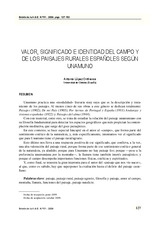Mostrar el registro sencillo del ítem
Valor, significado e identidad del campo y de los paisajes rurales españoles según Unamuno
| dc.contributor.author | López Ontiveros, Antonio | |
| dc.date.accessioned | 2010-10-22T08:05:09Z | |
| dc.date.available | 2010-10-22T08:05:09Z | |
| dc.date.issued | 2009 | |
| dc.identifier.issn | 0212-9426 | |
| dc.identifier.uri | http://hdl.handle.net/10396/3671 | |
| dc.description.abstract | The value, significance and identity of the Spanish countryside and of rural landscapes according to Unamuno.- Unamuno cultivated with a very personal style the literary genre dealing with the description and treatment of landscapes. At least five of his works belong entirely to this genre: Paisajes (1902); De mi País (1903); Por tierras de Portugal y España (1911); Andanzas y visiones españolas (1922) and Paisajes del Alma (1944). Making use of these works, among others, the purpose of this study is to analyze the relation between the Unamunian landscape and his central philosophical tenets, so as to identify the geographical spaces that especially favour meditative contemplation, which arises from the enjoyment of landscape. In this sense, there is a special focus on love of the countryside, which is part of the aesthetic feeling toward nature, and more specifically, there is an attempt to analyze the signification that the rural/agrarian landscape holds for Unamuno. This signification is certainly a positive one for a variety of reasons. First the rural landscape is highly valued as it takes part of the aesthetic feeling toward nature already alluded. Also for Unamuno, there is no ugly landscape. In spite of the Unamunian preference for the mountain, the plain is also interesting from the point of view of the landscape. And finally, the countryside plays important physical, aesthetic and spiritual functions. In the last place, I show that it is necessary to bear in mind the significance that the «landscape that saw our birth» had for the writer, together with his raving exaltations of the Castilian landscape. | en |
| dc.description.abstract | Unamuno practica una «modalidad» literaria muy suya que es la descripción y tratamiento de los paisajes. Al menos cinco de sus obras a este género se dedican totalmente: Paisajes (1902); De mi País (1903); Por tierras de Portugal y España (1911) Andanzas y visiones españolas (1922) y Paisajes del alma (1944). Con este material, entre otro, se trata de estudiar la relación del paisaje unamuniano con su filosofía fundamental para detectar los espacios geográficos que más propician la contemplación meditativa, que surge del goce paisajístico. En este contexto, se hace especial hincapié en el amor al «campo», que forma parte del sentimiento estético de la naturaleza, y, más específicamente, intentamos ver el significado que para Unamuno tiene el paisaje rural/agrario. Esto último nos lleva a una respuesta positiva de ese significado, que conlleva, a la vez, una alta valoración del paisaje rural, porque forma parte de ese sentimiento estético general de la naturaleza, ya aludido; porque para Unamuno no hay paisaje feo; porque —pese a la preferencia unamuniana por la montaña—, la llanura tiene también interés paisajístico; y porque el campo desempeña importantes funciones físicas, estéticas y espirituales. Y, como final, se muestra la gran impronta para el autor del «paisaje que nos vio nacer», al que, como es sabido, hay que superponer la exaltación hasta el delirio del paisaje castellano. | es_ES |
| dc.format.mimetype | application/pdf | es_ES |
| dc.language.iso | spa | es_ES |
| dc.publisher | Asociación de Geógrafos Españoles | es_ES |
| dc.rights | https://creativecommons.org/licenses/by-nc-nd/4.0/ | es_ES |
| dc.source | Boletín de la Asociación de Geógrafos Españoles 51, 127-152 (2009) | es_ES |
| dc.subject | Filosofía y paisaje | es_ES |
| dc.subject | Paisaje | es_ES |
| dc.subject | Amor al campo | es_ES |
| dc.subject | Funciones del paisaje | es_ES |
| dc.title | Valor, significado e identidad del campo y de los paisajes rurales españoles según Unamuno | es_ES |
| dc.type | info:eu-repo/semantics/article | es_ES |
| dc.relation.publisherversion | http://age.ieg.csic.es/boletin/51/06-LOPEZ.pdf | es_ES |
| dc.rights.accessRights | info:eu-repo/semantics/openAccess | es_ES |

